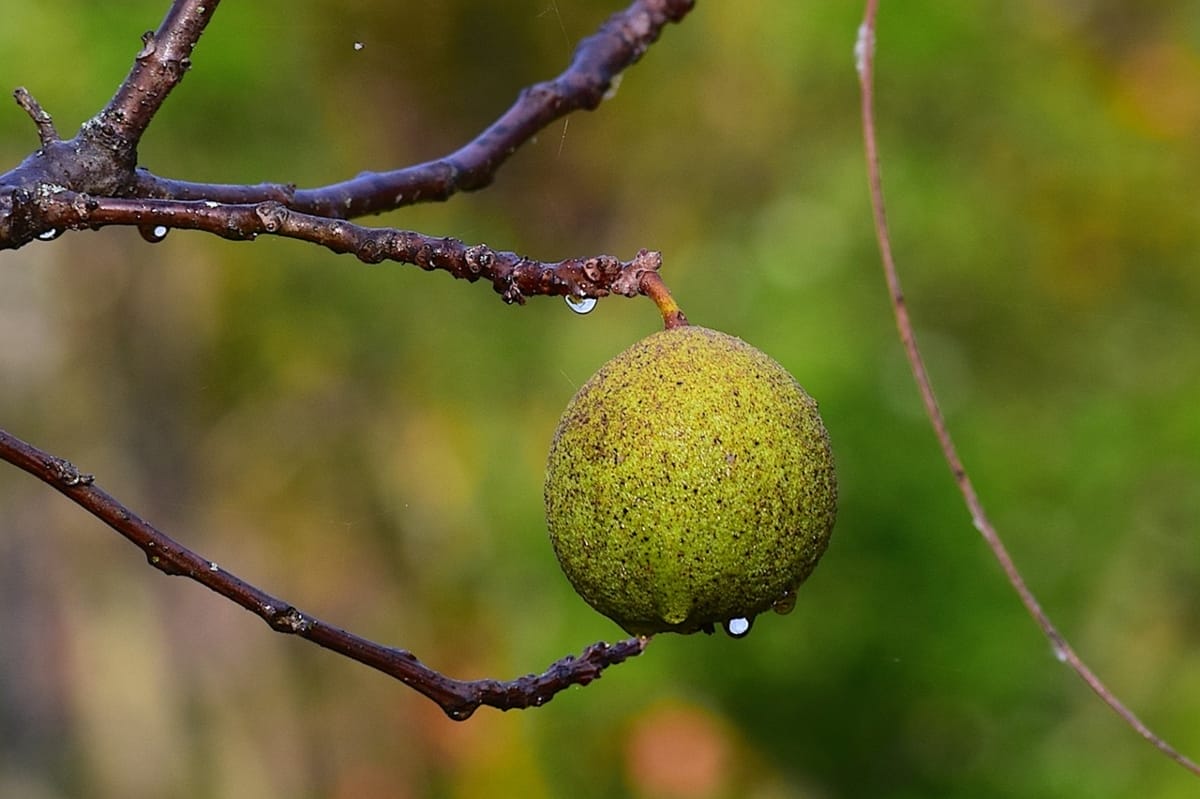

Uh oh...
It appears that you're using a severely outdated version of Safari on Windows. Many features won't work correctly, and functionality can't be guaranteed. Please try viewing this website in Edge, Mozilla, Chrome, or another modern browser. Sorry for any inconvenience this may have caused!
Read More about this safari issue.

The American Black Walnut is a unique nut for many reasons, and Arkansas is lucky enough to be home to many Black Walnut trees. The Black Walnut grows in the wild and is found in 32 states. Although our neighbor, Missouri, has the most Black Walnut trees, northern Arkansas has its share as well. Every fall, these giants drop large, green fruit to the ground. The nuts are hidden inside these outer shells.
Black Walnuts are one of the last remaining crops to be hand-harvested each year, and that harvest has long been a tradition for many families in Arkansas. The green outer cover of the walnut is fairly easy to remove, but it contains a toxin called juglone. This toxin is most potent in the hull and roots, which is why Black Walnut trees are notorious for killing the vegetation surrounding them. The toxin in the outer shells can irritate and stain skin, so wearing gloves is recommended when harvesting the nuts.

Black Walnuts have been harvested in Arkansas for hundreds of years, first by Native Americans, and then by settlers as they moved into the state. These walnuts have the hardest shell of any nut, and cracking them open to reach the nut inside is no small task. A heavy hand tool is required. In the past, shelling a Black Walnut was a tedious task. That all changed in the 1940s, when harvesting Black Walnuts became a commercial endeavor led by entrepreneurs who saw an opportunity to hasten the harvesting process.
One of these entrepreneurs was passing through Arkansas in 1936. Mandel Raffe was visiting a friend on his way to Texas. The native of Boston was originally on a trip to examine pecans, but became intrigued with Arkansas Black Walnuts and the possibility of harvesting them and selling them back East. Raffe decided to open a plant in Gravette, along with local brothers Allen and Clifton McAllister. The first operation began on Thanksgiving Day in 1936, with locals Lloyd Harris, Bertha Harris and Bob Dugan. At first, the walnuts were still harvested by hand. In 1946, the industry changed.
E.A. Smalley, an inventor in Kansas City, was trying to invent a way to separate nuts from their shells mechanically. He succeeded and filed the first patent for his machine. The Smalley Manufacturing Company began in 1930 and produced machines for the pecan industry. In the early 1940s, Smalley adjusted the machines for the more difficult work of shelling walnuts. Once these machines, called power hullers, became available commercially, the industry took off.

The walnut-harvesting company in Arkansas, known as the Gravette Shelling Company, was a staple in the community for nearly 60 years. In the 1960s, resident Lila Wiggan Givens wrote an article about Gravette for the Gravette News Herald. She described Gravette as “the black walnut capital of the nation.” In 1962, over $400,000 worth of walnuts were brought to the company from a seven-state area. The company also employed 160 people during the season, providing needed jobs for the area.
In addition to the jobs, harvesting Black Walnuts was, and still remains, a way for families to bring in a little extra income just in time for the holiday season. Families worked together to gather the nuts from trees on their properties and in the wild. This harvest still takes place today, and that income is just as welcome as ever.

In 1965, Mandel Raffe died, and Hammons Products Company purchased the Gravette Shelling Company. Hammons is a walnut-shelling business based in Missouri that is still in operation today. Gravette Shelling Company maintained its name after the sale, and Lloyd Harris continued to manage it. The company continued until 1998. Although Hammons closed the Gravette location, the Hammons Products Company continues to operate harvesting centers today.
In Arkansas, Hammons has three locations where local harvesters can bring their walnuts: Elizabeth, Flippin and Salem. The Black Walnut harvest in Arkansas runs through mid-November. Once the nuts are hulled, Hammons packages and sells them as Wild Black Walnuts, and many say their flavor is bolder than that of the more traditional English walnuts, bringing a unique taste to any product. Arkansas’s wild Black Walnuts can be found online through Hammon’s Pantry and at various retailers.

The Gravette Historical Museum maintains a display of news articles and photos of the Gravette Shelling Company. Though the company is no longer in business, it left its mark in the area as the Black Walnut center of Arkansas for many years.

Header Image of a Black Walnut on a tree by Robert Jones from Pixabay.
We do the work.
You check your email.
Sign up for our weekly e-news.
Get stories sent straight to your inbox!









Like this story? Read more from Kimberly Mitchell
The Razorbacks are famous across Arkansas and beyond. Many sports fans...
Women’s volleyball has become a central sport in Arkansas, deeply...
For many years, western Arkansas was the edge of the frontier. After the...
Join the Conversation
Leave a Comment